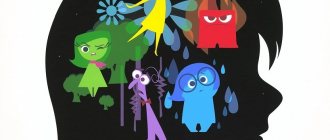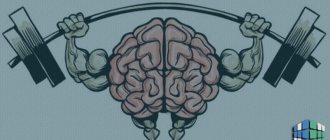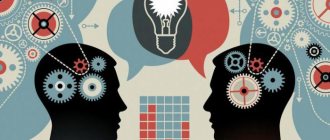Every person is endowed with five basic senses: vision, hearing, touch, smell, taste. But, depending on the characteristics of perception and processing of information, people can be divided into three main categories: visual, auditory and kinesthetic. And each person will definitely have one dominant sense organ. A lot depends on how we perceive reality.
If you ask several people to remember, for example, a forest, then one will immediately imagine a green crown of trees; another will associate the forest with birdsong; and the third will remember the fresh air and the touch of grass, leaves, cobwebs on the skin.
Also children. One child must write everything down in order to understand, another just needs to hear the information, and the third, if he doesn’t touch it, won’t remember anything.
School learning for a child is mainly a process of perception and assimilation of the information offered. The development of many important skills depends on which channel the child has.
Let's consider each of the channels of information perception.
How to understand what type a child belongs to?
I suggest taking a very useful test for children “CHANNELS OF INFORMATION PERCEPTION”
The test is intended for preschoolers and primary schoolchildren.
As you read the questions, note the traits that your child has. Then summarize and compare the results.
1. COMMUNICATION
If my child wants to say something, then...
Visual - speaks using the simplest figures of speech, pronounces some words and sounds incorrectly, and misses adverbs and prepositions.
Auditory - Uses the same figures of speech as adults, uses grammatically correct sentences, and tells carefully thought out stories.
Kinesthetic - speech is difficult to understand, speaks in short, grammatically incorrect sentences, strives to depict events instead of telling about them.
2. FAVORITE TOYS AND FREE TIME
While playing, my child...
Visual - prefers puzzles and board games, enjoys computer games or games with a calculator, learns about new things by observing.
Auditory - loves listening to audio recordings, loves books and fantasy play. learns new things by reading instructions.
Kinesthetic person - loves to play in the fresh air, enjoys being in the pool, skating rink or slide, and finds full use for almost every toy.
3. COMPLEX MOTOR SKILLS
When my child starts doing something with his hands, then...
Visual - he writes diligently, his works of art are very neat and beautiful, he can easily cut out, paint, and glue together.
Auditory - writes quite well; he talks to himself while working.
Kinesthetic - he writes with difficulty, many of his letters and numbers turn out ugly, his work is untidy.
4. SIMPLE MOTOR SKILLS
When my baby starts moving...
Visual - he considers board games better than outdoor games; he loves games with clearly established rules.
Auditory - talks more than plays; prefers games that require verbal communication; during any activity he talks to himself.
Kinesthetic - considers outdoor games better than board games, has good coordination, does not walk quietly, but rushes about.
5. SOCIAL SKILLS
When my child is surrounded by other children, then...
Visual - even in a crowd he remains alone; before taking part in the game, watches how others play; takes a long time to get used to new people.
Auditory - literally blossoms among friends; may interfere during classes because she talks a lot; often takes responsibility for others and behaves somewhat dismissively.
Kinesthetic - collectivist, but not very talkative; can cause anxiety because he interferes with his neighbors during class activities and likes to play pranks.
6. EMOTIONS
When a child is worried about something, he...
Visual - not very emotional, begins to get nervous, feeling the concern of others.
Auditory - freely talks about his feelings, can go into confrontation with others about his feelings.
Kinesthetic - emotionally dependent and easily offended; when called to order, he reacts angrily, without embarrassment or repentance.
7. MEMORY
When my child studies, he...
Visual - can reproduce letters and numbers from memory; remembers what was shown to him.
Auditory - learns best by memorizing; knows the sounds corresponding to the letters of the alphabet.
Kinesthetic person - does not remember well, is easily distracted.
8. SCHOOL SKILLS
When my child is in the classroom, he...
Visual - monitors the neatness of his clothes and the cleanliness of his workplace; in his free time he prefers construction sets, puzzles, various types of art and crafts; slowly gets used to the new situation.
Audial - his appearance is not very sloppy, but not very neat either; he has to be reminded to clean his work area; he is attentive and obedient.
Kinesthetic - does not care at all about his appearance and is often very unkempt; works in an environment of complete chaos; is able to turn over his workplace in a few minutes; is very active during games; forced to sit in one place, literally writhing and squirming.
One of the definitions - auditory (auditory perception), visual (visual perception) or kinesthetic (tactile perception) - most likely received the most marks. This channel of information perception means the way of cognition that is most characteristic of your child.
A little theory
Each person perceives the world in his own way.
Its perception is based on one or another channel of information: visual (visual), auditory (auditory), kinesthetic (bodily). We use our senses not only to perceive the external world, but also to imagine these experiences to ourselves, i.e. represent. Hence the name representational systems - these are the pathways through which we receive and store information in our brains. We use all of them constantly, although we are not aware of them to the same extent, giving preference to some and “forgetting” about others.
There are leading systems that we use most often to process information. So, many people think mainly in pictures, as if replaying a movie in their head. Others find this difficult and prefer to engage in internal dialogue. Still others will prefer to base their actions on internal feelings in relation to the situation that has arisen (“warms the soul” or not, “catches”). Therefore, different people become more successful at solving particular problems, depending on what the specifics of that task are. For example, a musician’s auditory channel of perception will be clearly more developed, while an athlete needs to develop a kinesthetic channel. An architect, by virtue of his profession, prefers to think in images
There are very few people who equally master all channels of perception and processing of information and can use them at their own discretion. Although representational systems are not mutually exclusive, basically, a person has one leading channel for perceiving, processing and storing information, the second is auxiliary, and the third is the least developed.
Visual child
Visual learners instantly remember faces, but often forget first and last names. They easily find their way even to places they have only been to once. The speech of visual children is filled with the words “look”, “have you seen”, “beautiful”, “bright”, “red”, “green”... They think in images. In the process of thinking, pictures from the past, ideas about the future, images appear in their heads, and imaginary situations are played out. Little visual learners have a wild and lively imagination.
Children with visual perception do not like hugs and kisses, but they will willingly talk to you about adult topics. They usually look older than their age because they keep themselves aloof and a little arrogant. They love to lecture their elders and quote phrases “from TV,” which they adore. They sense your mood and desires by your facial expressions, but do not always let you understand this (of course, in their own interests). Visual learners have excellent visual memory and fine motor skills are well developed, but they have difficulty understanding verbal instructions and often repeat tasks. Quickly remembers color, shape, size. They find it easy to tell stories based on pictures. Their eyes are always searching for information.
Visual children begin to write in block letters early and can read quite fluently by the time they reach school. In raising a visual student, it is necessary to pay attention to the development of speech (he is taciturn), sociability (the ability to communicate), and physical coordination. Visual students remember the teacher’s explanations more easily if they are duplicated on the school board or on diagram posters: it is easier for them to see and visually remember the word than to understand the rule why they should write it that way. Visual aids, illustrations, the use of colored pencils: sketch, reproduce, highlight - all this contributes to better assimilation of the material.
Allow your child to use colored pens to highlight important points in the book. As visual learners, it is vital for them to have a draft in which they can draw and draw.
Visual (visual) channel
If a person has a dominant visual channel (or is currently configured to perceive video information), then outwardly this will be expressed in the following signs:
1. The eyes will look up, above the horizon line. Which is quite understandable: the sky is above, the sun is there - there is more light there;
2. Upper, chest breathing;
3. Voice is high;
4. Speech is fast, sometimes excitedly. There is often a noticeable increase in intonation towards the end of a sentence. Which is also understandable: upper breathing is the most ineffective - a small volume of air is inhaled and during exhalation you need to have time to express a thought, finish a sentence;
5. All gestures from above - at the level of the shoulder girdle and above;
6. Such a person likes to dress brightly;
7. Appearance: pale face. The body is most often slender and thin. The shoulders are relatively broad and usually raised. The head is thrown back;
8. Predicates: light, dark, bright, beautiful, see, look,... That is, words that relate to the characteristics of light, color and visual perception.
Note: Predicates are words that a person uses to describe his or her perceptions.
The visual channel is associated with the ajna chakra (third eye), as well as with the mental body.
Auditory child
These children remember in great detail who said what, where, when, and in what words. They instantly “grab” first names and patronymics, but easily forget faces. Their greatest pleasure is conversation; they will never be interested in a book if they have someone to talk to. All secrets and news immediately become known to them. No, they are not specifically trying to find out what you are talking about, it’s just that their hearing is much better developed than others. Auditory children have a large vocabulary, but may lag slightly behind their peers in the development of skills related to visual (finding differences in pictures) and motor (the ability to deftly climb a slide, run quickly and for a long time) perception.
In their speech, auditory learners often use the words “listen”, “hear”, “noisy”, “quiet”.
Such children think through internal speech, mentally pronouncing their own remarks and the interlocutor’s answers, assuming what kind of voice he will have, what intonation. They love the radio. They like television programs that are dominated by “words” rather than “pictures.” They are very attentive in conversations. In a conversation with an auditory speaker, it is useful to use vocal features: pauses, intonation, volume.
In primary school, auditory learners often study well; their strength is developed auditory memory and speech, but they often have difficulties with spelling and drawing. In middle school, auditory learners who are accustomed to using their memory usually demonstrate significantly less success. During this period, you should pay more attention to reading, pronouncing, and repeating the rules out loud. Auditory learners are musical and easily grasp foreign languages. They are recommended to use audio materials first. When doing homework, such children may move their lips and talk to themselves. Another feature of auditory learners that is associated with difficulties at school is the ability to tell only from the very beginning.
Auditory (hearing) channel
If a person has a dominant auditory channel , then outwardly this will be expressed in the following signs:
1. The eyes will move approximately in a horizontal plane, along the horizon line. This is due to the fact that an auditory person is tuned to perceive sounds. In nature, sounds that deserve attention usually occur at ground level, or at a short distance from it;
2. Medium, costal breathing;
3. The voice is average - not high and not low;
4. Speech is expressive, smooth, without raising or lowering intonation;
5. Gesturing at an average level, approximately at chest level. This is table or podium level;
6. In clothes, such a person prefers an official style, or at least not too bright;
7. Appearance: the face is evenly colored, the body type may be different;
8. Predicates: quiet, loud, listen, noisy, heard, etc. - words related to the characteristics of sound;
The auditory channel is to some extent connected with the chakras: manipura, anahata and vishuddha. And also with the astral body.
Digital representational system
Scientists identified this system of perception not so long ago. For a person with such a representative system, symbols - words and numbers - come first when perceiving the world around them. Their type of perception is aimed at logical justification of everything that happens around them. Digitals are excellent strategists. They are excellent at planning and handling details. Solving complex problems is their strong point. Information is processed and remembered step by step, sequentially, methodically, logically, putting everything on the shelves. They need a certain amount of time to process information. Therefore, new ideas, situations, people are not immediately perceived. They need time to think and comprehend.
Signs of perception
Perception is a cognitive process in psychology, the result of which is the formation of a subjective picture of the world through the direct impact of an object or phenomenon on the human senses.
The completed image of an object in the human mind is formed as a result of the combined work of various analyzers. Thus, through vision one can draw a conclusion about the color of an object, and through tactile palpation one can obtain information about its texture. If you take an object in your hands, you can feel its weight, with the help of smell you can feel its smell, and through the receptors on the tongue you can determine the taste. It turns out that in the process of getting to know a subject, cognition and perception merge together.
Important! Perception is always subjective. Individual characteristics of the work of analyzers and a person’s life experience explain the fact that the finished image of an object perceived by different people may differ
The process of perception is inextricably linked with thinking, attention, memory, speech, and the emotional-volitional sphere
Kinesthetic world, I feel you
There are people who do not trust either words or visual images. Their knowledge of the world is based solely on their own tactile, sensory and olfactory sensations. Such people in psychology are called kinesthetics. They are the type who prefer to measure seven times before cutting. How to recognize a kinesthetic person:
- in personal relationships, kinesthetics do not love with their ears, gifts are not important to them, but hugs are what will convince them of the sincerity of their feelings;
- the highest degree of recognition and trust for such people is touch;
- when making decisions, kinestechs are guided by the category “it seems to me”;
- in evaluating objects and events, the recommendations of other people are alien to them, they do not believe advertising and do not listen to reviews - such people care about their own feelings;
- to solve a problem, kinesthetic learners need to take it apart into its components, study each detail separately, and then put it back together into a single whole;
- in everyday life they value comfort and do not attach importance to style and fashion trends;
- when perceiving information, they are guided by the principle “you have to try”, so practice for them is above all;
- Kinesthetic people are sensitive natures and easily enter into the position of another person.
There are much fewer kinesthetics in society than visual and auditory people. With their heightened degree of sensitivity, it is much more difficult for them to find their place in the world around them. From the motto: “I feel, therefore I exist.”
History of the study
Surprisingly, the study of proprioception began two hundred years ago. In 1826, neurologist Charles Bel wondered what other functions muscles had other than contracting at the command of motor neurons. He came to the conclusion that they also “tell” the brain about the position of the body and limbs, if there is no other way to know about it (for example, if you cannot see your hands).
In 1887, neurologist Henry Charlton Bastian proposed replacing the term "kinesthesia" with the general terms "muscle sense" and "pressure sense." According to Bastian, kinesthesia is the perception of body and limb movements in space, the degree of effort and weight applied.
Almost twenty years later, in 1906, neurophysiologist Charles Scott Sherrington separated the terms “proprioception,” “extreception,” and “interception.” Proprioception, he said, is the sensation of the body that comes from sensory receptors - proprioceptors located in the muscles, ligaments, and joints.
Interception and extroception give the brain information about internal organs and the external world, respectively.
Initially, scientists argued that the brain has an idea of the position of the limbs from the muscles. In the 20th century, they attributed this role to the joints, relying on studies of stretch receptors in the knee joints of cats. Today, the opinion has changed, and most neurologists believe that the principle of proprioception is based on muscle receptors.









